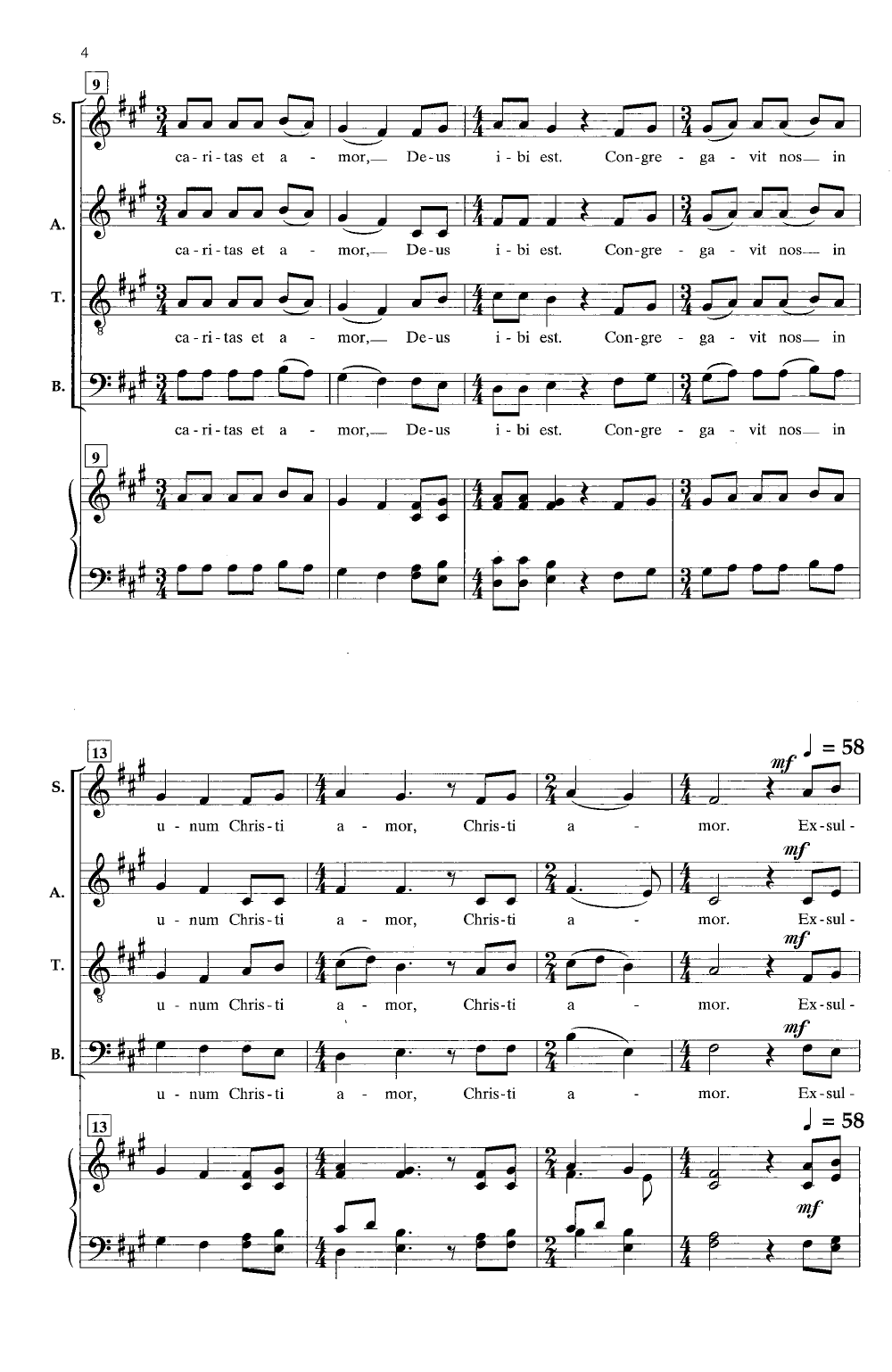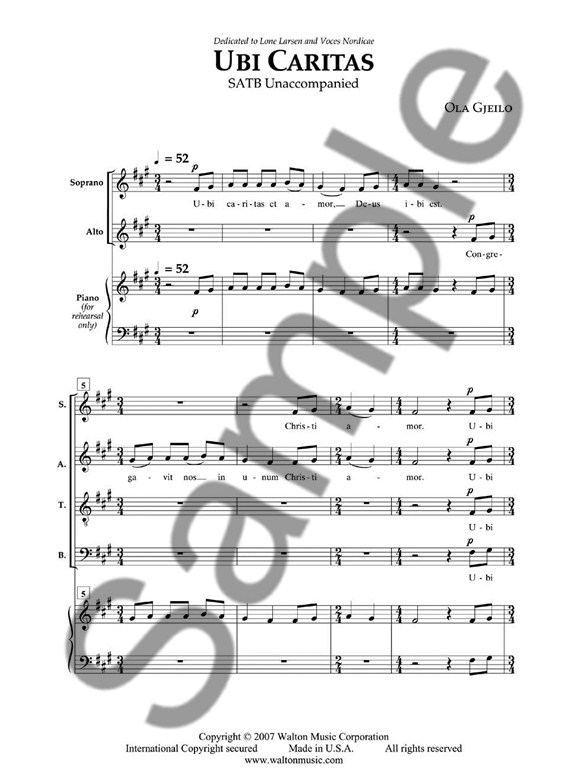Sofia Vokalensemble performing ”Ubi Caritas' including piano improvisation by Ola Gjeilo at a concert in Vilnius, Lithuania on May 19th 2018. Lyrics: Ubi car. In time, Ubi Caritas will become one of your chestnuts, just as it has for us. There’s a reason why Ubi Caritas remains Ola Gjeilo’s top-selling motet at Walton Music, despite the fact that he has since composed many other impressive works. This is an immensely satisfying piece to have in your choir’s repertoire.
- Ubi Caritas Ola Gjeilo Piano Pdf Download
- Ubi Caritas Ola Gjeilo Sheet Music Pdf
- The Ground Ola Gjeilo Pdf
- Tundra Ola Gjeilo Pdf
- Sanctus Ola Gjeilo
Ubi Caritas Ola Gjeilo Piano Pdf Download
- Vocal Forces: Piano Improvisation Transcription Description: Pianist/Conductor's score featuring the transcription of Ola Gjeilo's piano improvisation over his Ubi Caritas (SATB version), as performed by the composer and the Central Washington University Chamber Choir in their popular 2011 YouTube video. Singers can perform from the original SATB octavo score, WW1386.
- View Download PDF: Ubi caritas conducteur (14 pages - 360.48 Ko) 116x⬇ CLOSE Now that you have this PDF score, member's artist are waiting for a feedback from you in exchange of this free access.

With our upcoming concert with Ola Gjeilo just days away, we wanted to give you a sneak peak into the wonderful music in store for you if you come! As usual, Susan Wladaver-Morgan has written some stellar program notes for us. Sit back and enjoy, and then order your tickets here. We can’t wait to see you there!
The Music of Ola Gjeilo
How often do singers get the chance to perform with the composer himself at the piano? The Choral Arts Ensemble has enjoyed this amazing experience twice in two years, and we proudly and gratefully welcome back one of the leading choral composers in the world today, Ola Gjeilo. In addition to CAE and the Pacific Youth Choir singing as he plays, we will all get to hear him improvising with his Juilliard friend Thomas Barber and as a soloist.
Born in Oslo, Norway, composer Ola Gjeilo (b. 1978) moved to the United States in 2001 to study composition at Juilliard and film music at the University of Southern California; he now lives in New York. He knew he wanted to be a composer from a young age. Despite his many classical compositions, he also has a passion for improvisation and jazz as both composer and performer, and some of his works combine his interest in choral music and improvisation. He has received the 2016 Brock Commission for a new work to be performed at all seven of the American Choral Directors Association Division conferences in the United States next year. His Sunrise Mass has been performed at Carnegie Hall, and Dreamweaver received its world premiere at the same concert in May 2014. We will be performing portions of both these works in tonight’s concert.

The Pacific Youth Choir opens the concert with “Evening Star.” Edgar Allan Poe (1809-1849) wrote this poem and published it in his first anonymous collection, Tamerlane and Other Poems, in 1827 when he was only eighteen, making the song even more appropriate for these young singers. Unlike many of Poe’s later stories and poems, this poem takes a more positive view of romantic love, with none of the gloom and despair of his later work. It contrasts the cold light of the moon with the more welcoming light of the Evening Star, which may be the planet (and by implication, the goddess) Venus. Some critics have suggested that Poe was using the heavenly bodies to represent two specific women in his young life, but even this early work shows his exquisite poetic skill.
The women of CAE and the PYC next perform “Tundra,” which depicts a specific place—the Hardangervidda region of Norway, a mountain plateau between Oslo and Bergen not far from where Gjeilo’s father grew up. Gjeilo’s studies at USC included film music, and “Tundra” paints visual images like the film scores he admires. “Tundra” grew out of a collaboration with Charles Anthony Silvestri (b. 1965), who has provided lyrics for many composers. “Collaboration between composer and poet is magic,” Silvestri argues. “It opens for the composer opportunities for organic and dynamic creation not possible with previously published poetry, and gives the poet the thrill and responsibility that his words will be sung–not read–and will be heard attached to an emotional soundtrack.” In this piece, the repetitive piano part and the sustained downward lines of the women’s chorus induce a sense of being held in place in an unyielding landscape that knows its own strength; at the same time, a solo soprano voice soars above it like fast-moving clouds.
Gjeilo composed “Northern Lights” in an attic near Oslo, Norway in 2007. He has written: “Looking out from the attic window that Christmas in Oslo, over a wintry lake under the stars, I was thinking about how this “terrible” beauty is so profoundly reflected in the northern lights…which, having grown up in the southern part of the country, I have seen only once or twice in my life. It is one of the most beautiful natural phenomena I’ve ever witnessed and has such a powerful electric quality that must have been both mesmerizing and terrifying to people in the past.” Even though the music is “quite serene on the surface,” both the music and the words are about a “terrible, powerful beauty.” The text comes from the Song of Solomon in the Bible, in which a man and a woman rejoice in their desire for each other; Jewish and Christian scholars have seen it as an allegory for God’s love for his people. But both the Northern Lights and human desire share the ability to inspire wonder, joy, an electric thrill, and even terror with their power.
Ubi Caritas Ola Gjeilo Sheet Music Pdf
“The Spheres” opens Gjeilo’s Sunrise Mass, and, following his recent practice, he has given English titles to many of his pieces with Latin texts. He has written of this Kyrie: “I wanted the musical evolution of the Mass to go from the most transparent and spacey to something completely earthy and grounded, from heaven to earth, so to speak. So in The Spheres, I used a kind of overlapping fade-in fade-out effect to give a sense of floating in space, in darkness and relative silence, surrounded by stars and planets light-years away.” He achieves this striking effect in several ways: by dividing the choir into as many as sixteen separate vocal parts in places and by breaking up the very words into unconnected syllables that drift from one voice to another, softly overlapping in dissonance before resolving into new chords like “church bells beyond the stars heard.”
The Ground Ola Gjeilo Pdf
“Ubi Caritas” is among the very oldest Christian hymns, dating at least to the Middle Ages and perhaps even before the Church had arrived at the traditional form of the Mass. It recalls Jesus’ words, “Where two or three are gathered in my name, there am I in the midst of them,” and it remains a frequent part of Maundy Thursday services. Gjeilo’s wonderful setting resembles early Gregorian chant versions in places, but here enhanced by his own added piano improvisation over the choir.
We open the second half with “The City,” as Gjeilo titled the Credo of his Sunrise Mass. Where “The Spheres” (Kyrie) feels ethereal, above and apart from earthly things, “The City” brims with nervous energy in its accompaniment and begins with a literal grounding in the sturdy bass line. This yields to the altos presenting the Incarnation in Gregorian-style chant and the full choir dramatically describing the Passion of Christ. The movement ends with all voices repeating the word “Credo” (I believe) over and over, against the same busy accompaniment as at the beginning, reinforcing the emergence of the “collective humanity” in the Sunrise Mass’ third movement.

Tundra Ola Gjeilo Pdf
The haunting “Chorale,” with its mysterious images of suffering and doom, actually comes from a much larger work titled Dreamweaver, with lyrics again by Charles Anthony Silvestri. The inspiration grew from a medieval Norwegian poem called Draumkvedet (Dreamsong) that envisions a world of people living without hope, trapped by sin, grief, and regret—almost like Dante’s Inferno. But at the end, St. Michael arrives to fight Satan, and then Christ comes to free souls from their guilt with his love. “Chorale” comes from the middle of this longer work.
We welcome back the Pacific Youth Choir for the last two pieces. Gjeilo has written of “Serenity” that “I wanted to write a cappella music that has a symphonic, abundant feel….I love the warm, lush sound that can give a feeling of space and evocativeness, but still be intimate somehow. But mainly, all I wanted to do with this piece was to write something that came straight from my heart, without any pretense or filters.” With the text of “O Magnum Mysterium,” which meditates on the mystery of Christ’s birth, Gjeilo uses a technique similar to that in “Spheres”—dividing words into separate syllables and letting the rich sound of each one blossom as if there were no such thing as time.
Sanctus Ola Gjeilo
We close the concert with “The Lake Isle.” Anglo-Irish poet William Butler Yeats (1865-1939) wrote the poem on which it is based, “The Lake Isle of Innisfree,” in 1888. The poem describes the rural landscape of County Sligo in western Ireland where Yeats spent nearly all his summers as a boy. He got his inspiration for the poem suddenly from the sound of a fountain in London and considered the poem “my first lyric with anything in its rhythm of my own music.” Listeners can hear rippling water throughout the song in the rhythmic repetition of the words “Innisfree go to Innisfree,” like water gently lapping at the shore. Even more, the ever-moving piano part continues, as it did for Yeats, wherever he is—country or city—for the memory lives, like music itself, in the heart.
Susan Wladaver-Morgan